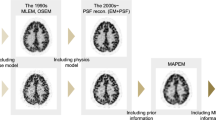Abstract.
The human cardiac nervous system consists of a sympathetic and a parasympathetic branch with (–)-norepinephrine and acetylcholine as the respective endogenous neurotransmitters. Dysfunction of the cardiac nervous system is implicated in various types of cardiac disease, such as heart failure, myocardial infarction and diabetic autonomic neuropathy. In vivo assessment of the distribution and function of cardiac sympathetic and parasympathetic neurones with positron emission tomography (PET) and single-photon emission tomography (SPET) can be achieved by means of a number of carbon-11-, fluorine-18-, bromine-76- and iodine-123-labelled tracer molecules. Available tracers for mapping sympathetic neurones can be divided into radiolabelled catecholamines, such as 6-[18F]fluorodopamine, (–)-6-[18F]fluoronorepinephrine and (–)-[11C]epinephrine, and radiolabelled catecholamine analogues, such as [123I]meta-iodobenzylguanidine, [11C]meta-hydroxyephedrine, [18F]fluorometaraminol, [11C]phenylephrine and meta-[76Br]bromobenzylguanidine. Resistance to metabolism by monoamine oxidase and catechol-O-methyl transferase simplifies the myocardial kinetics of the second group. Both groups of compounds are excellent agents for an overall assessment of sympathetic innervation. Biomathematical modelling of tracer kinetics is complicated by the complexity of the steps governing neuronal uptake, retention and release of these agents as well as by their high neuronal affinity, which leads to partial flow dependence of uptake. Mapping of cardiac parasympathetic neurones is limited by a low density and focal distribution pattern of these neurones in myocardium. Available tracers are derivatives of vesamicol, a molecule that binds to a receptor associated with the vesicular acetylcholine transporter. Compounds like (–)-[18F]fluoroethoxybenzovesamicol display a high degree of non-specific binding in myocardium which restricts their utility for cardiac neuronal imaging.
Similar content being viewed by others
Author information
Authors and Affiliations
Additional information
Electronic Publication
Rights and permissions
About this article
Cite this article
Langer, O., Halldin, C. PET and SPET tracers for mapping the cardiac nervous system. Eur J Nucl Med 29, 416–434 (2002). https://doi.org/10.1007/s002590100640
Published:
Issue Date:
DOI: https://doi.org/10.1007/s002590100640




